On This Page
How to Grow Stock Flowers
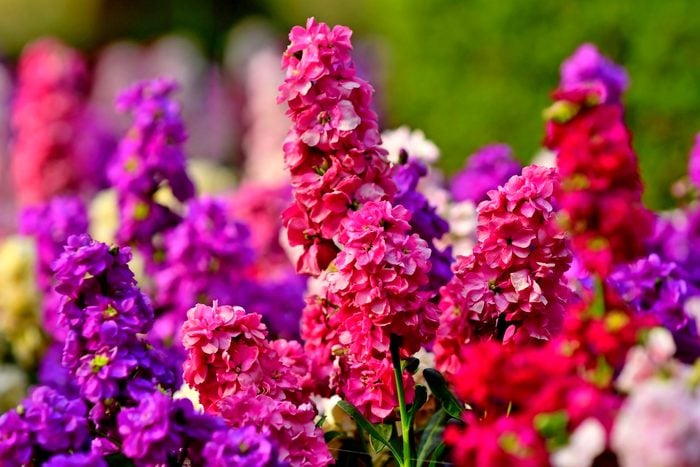
- Common name: Stock flower, Brompton stock, Gillyflower
- Scientific name: Matthiola incana
- Hardiness zones: 7 to 10
- Light needs: Full sun to partial shade
- Watering needs: Average, keep soil consistently moist but not waterlogged
- Preferred soil: well-drained, fertile, pH of 6.0 to 7.5
- Size: 10 to 36 inches tall, 6 to 18 inches wide
- Flower colors: white, pink, purple, lavender, red, yellow, apricot, blue, rose pink, bicolor or multicolor
- Attracts: Bees and butterflies
Spiky, colorful stock flowers are relatively easy to grow and low-maintenance once established, making them a good choice for both new and experienced gardeners. But they do require specific conditions.
“Stock thrive in fertile, well-drained soil,” says Dr. Christine Coker, horticulturist and professor at Mississippi State University. “Good plant nutrition is necessary for better quality; however, high levels of nitrogen can cause weak stems.” They can also be sensitive to potassium deficiency. For this reason, it can be helpful to get a soil test and make necessary amendments before planting.
When and Where to Plant Stock Flowers
Plant stock flowers in full sun in cooler zones or dappled sun in hotter and drier climates. Depending on your preferences, you can grow them from seeds or potted plants. “Starting from seeds gives you a wider variety of options, while starting with potted plants can give you a head start in the growing process,” says Laura Root a horticulturist at Park Seed.
Transplant seedlings or potted plants in early spring, after the last frost, with plenty of space to grow. To encourage longer stems for cut flowers, Christine recommends spacing them on six-inch centers. You can also plant them in the fall for early spring blooms.
“They do well in cool weather and are typically grown as annuals,” says Laura. “However, in warmer climates, they may reseed and act as biennials. They also make great container plants, so you can add them to your garden bed or place them on a patio or balcony.”
Stock Flower Problems
To prevent wilting and stress, stock flowers need consistent moisture levels, and never let them dry out. Use a trellis or other support for taller varieties and regularly deadhead them, removing spent blooms to encourage new growth and prolong blooming.
As for pitfalls, watch out for aphids, thrips and fungal diseases.
Stock Flower Benefits
With their spiky stalks and variety of bright colors, stock flowers make both your garden and home décor come alive. They’re ideal for bouquets, centerpieces, focal flowers and corsages since they last up to two weeks after being cut.
“Stock flowers are renowned for their delightful fragrance, which is often described as a mix of cloves, cinnamon and vanilla,” says Laura. “This sweet and spicy scent makes them popular choices for perfumes and potpourri.”
They can also be used as a garnish, says Christine, though the flowers are bitter. When springtime temperatures begin to rise, they stop producing marketable flowers.
Stock Flower Meaning
They also come rooted in tradition. “In the language of flowers, stock flowers symbolize lasting beauty and a happy life,” says Laura. “They are often included in bouquets for weddings and other celebrations.”
Do Stock Flowers Attract Pollinators?
Some varieties release their fragrance in the evening, attracting nocturnal pollinators like moths and bats. During the day, their bright blooms also help butterflies, bees and other important pollinators.
“By providing a food source for these pollinators, stock flowers can help support a healthy ecosystem in your garden,” says Laura. “Additionally, the flowers themselves can serve as shelter for small insects and other wildlife. Adding stock flowers to your garden can contribute to a more diverse and vibrant environment.”
Stock Flower Varieties
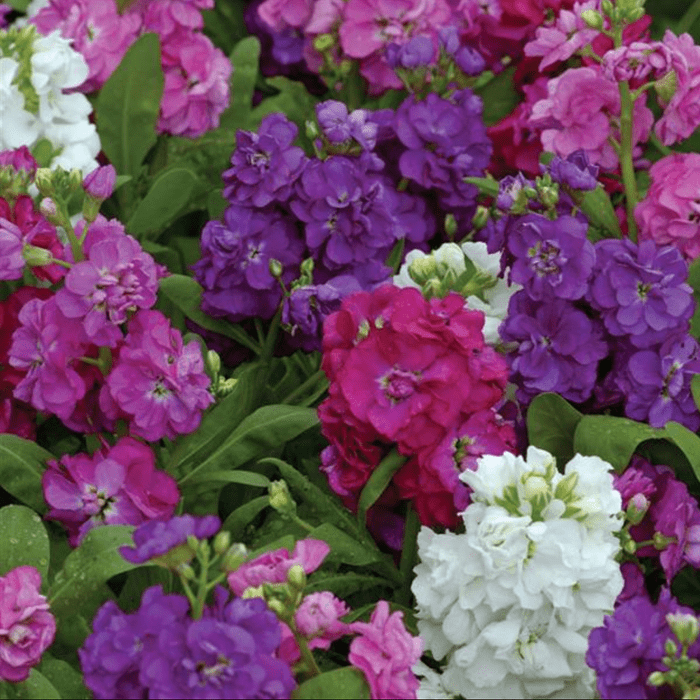
“For cut flower use, I am particularly fond of the Katz Series which is available in apricot, blue, pink, white, purple, rose pink, rose and yellow,” says Christine.
Laura’s top pick is Hot Cakes, an interesting variety known for vibrant and eye-catching blooms in bold colors including deep purple, bright pink or fiery orange. “It produces large, double flowers that add a pop of color to garden beds or floral arrangements,” she says. “They perform best in cool weather and give an excellent fragrance in early spring.”
About the Experts
Laura Root is a horticulturist and senior product manager at Park Seed. She has 12 years of experience in the green industry and holds a degree in environmental horticulture from Virginia Tech University. Plants are her passion, but her joy especially comes from sharing her knowledge with others.
Dr. Christine E.H. Coker is a research and Extension professor of urban horticulture at Mississippi State University’s Coastal Research and Extension Center Beaumont Horticultural Unit. She has more than 20 years of experience sharing her love of plants with gardeners of all skill levels.
Why Trust Us?
For nearly 30 years, Birds & Blooms, a Trusted Media Brand, has been inspiring readers to have a lifelong love of birding, gardening and nature. We are the #1 bird and garden magazine in North America and a trusted online resource for over 15 million outdoor enthusiasts annually. Our library of thousands of informative articles and how-tos has been written by trusted journalists and fact-checked by bird and garden experts for accuracy. In addition to our staff of experienced gardeners and bird-watchers, we hire individuals who have years of education and hands-on experience with birding, bird feeding, gardening, butterflies, bugs and more. Learn more about Birds & Blooms, our field editor program, and our submission guidelines.
On This Page
What Does a Black-and-White Warbler Look Like?
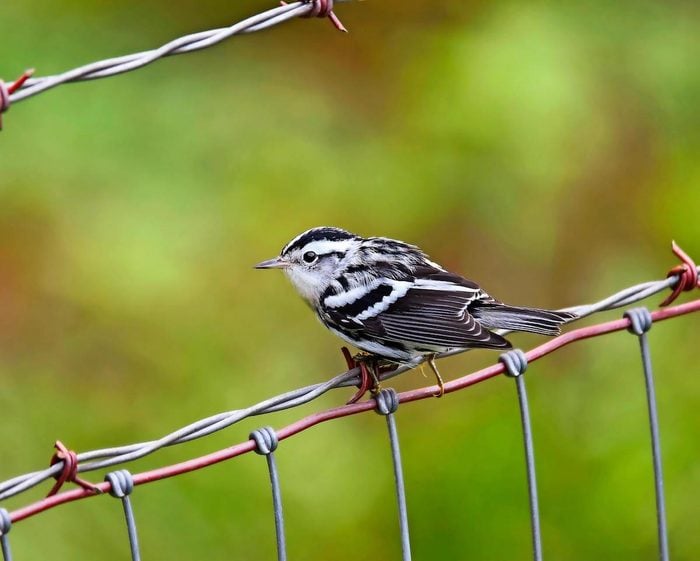
With distinctive, bold black and white stripes from the crown of their head to their tail feathers, the black-and-white warbler is much easier to identify than most other warblers.
“They probably have one of the best names of any warblers,” says Keith Arnold, Professor Emeritus at Texas A&M University.
Keith says the only confusion might involve the blackpoll warbler, yet they are distinguished from the black-and-white warblers by their noticeable black cap and white cheek.
Black-and-white warblers are medium-sized wood warblers between roughly 4 to 5 inches long with a short neck and tail. They have particularly long hind claws to assist them while scurrying along tree trunks. The birds also feature a slightly curved-downward bill that is perfect for plucking insects from the bark and branches of trees.
At first glance, it’s a little trickier telling the males and females apart. The females are generally paler in their markings, plus they have a pronounced white patch on their throat and a grayish ear patch. If you can spot it, the females also have black spots on the undertail feathers between the belly and the tail.
Range and Habitat
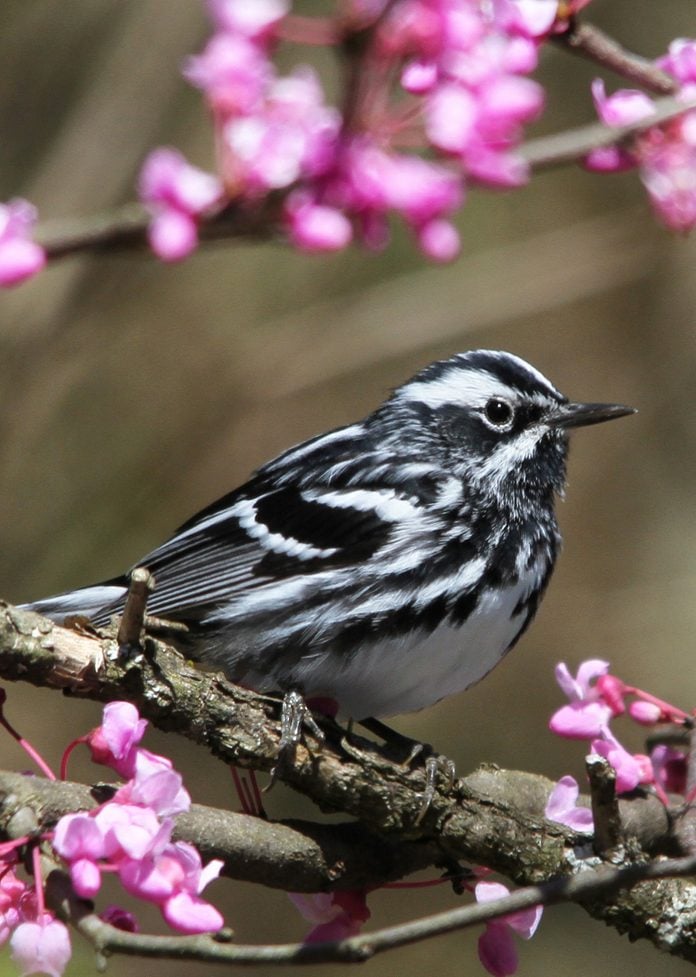
“They are neat little birds, and are widely distributed, as well,” says Keith. “They breed in deciduous and mixed woodlands in the Eastern and Central US and into Canada.” This includes as far southwest as Eastern Texas and stretching into the Northwest Territory during the summer months.
These warblers are considered long-distance migratory birds, and will overwinter in Mexico, Central America, the West Indies and Bahamas, as well as northern South America. And there are reports of some birds spending the winter in California. In many areas, the migration begins in August. They are some of the first to return in the spring, finding their way back to New England and southern Canada by May.
Because they cover extended distances, Keith notes there are high mortality rates every year. “There was a fallout on the coast, and there were 1,400 that died of exhaustion from crossing the Gulf of Mexico,” he notes.
Nesting Habits and Eggs
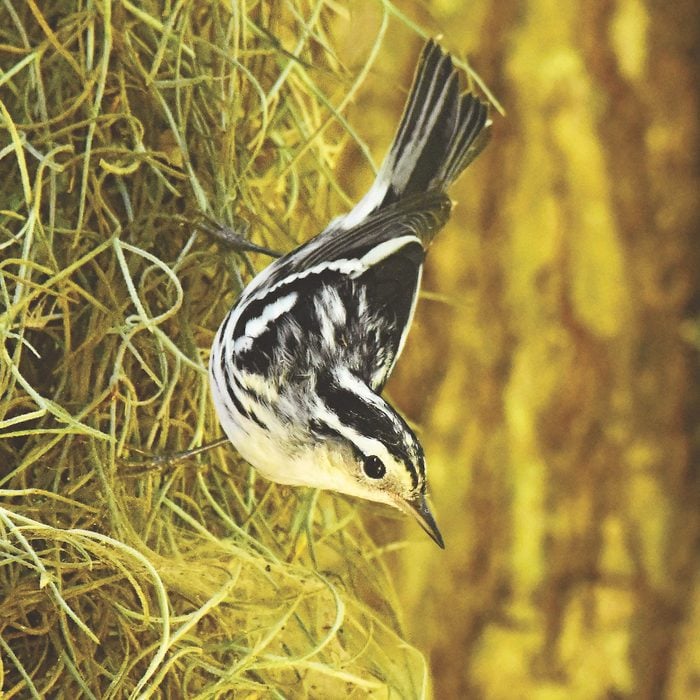
While most other warblers nest in the trees, Keith points out, “They are ground nesters. They build a little cup-shaped nest on the ground, often in a cavity or next to a tree stump.”
Scientists still aren’t certain as to how they build their nests, and whether one or both parents take part in the process. They’re typically constructed of course grasses, dried leaves and pine needles with the softer interior consisting of shredded bark, moss, grass and even horsehair.
Keith notes that they produce one brood a year. The eggs are laid in successive days. Incubation by the female begins when the next to last, or the last, egg is laid, and lasts between 10 and 12 days.
Most of the eggs white or creamy white, although there are some that might have a pale blue or greenish tinge to them. “They are quite variable in the coloration of spots,” he says, noting that they might have fine brown spots, or a pale lavender.
Both the parents tend to the young, which leave the nest between eight and 12 days after they hatch.
What Do Black-and-White Warblers Eat?
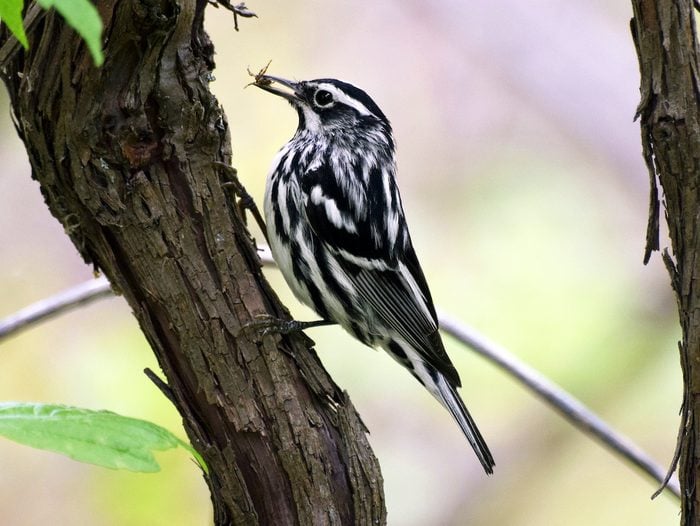
Like nuthatches and brown creepers, you’ll notice black-and-white warblers foraging along the trunk of trees, as well as in the crevices of branches and tips of the limbs looking for caterpillars, beetles, and a wide variety of insects. Their genus name, Mniotilta, means “moss-plucking” because of their tendency to poke around moss and other areas where insects might be hiding.
Because of their insect-focused diet, they’re not interested in seeds. Keith says, “Normally they come into the feeder because they are eating the insects that also come into the feeder.”
One of the best ways to encourage them in your backyard is to have trees, native shrubs and perennials that host the insects black-and-white warblers feed upon.
Black-and-White Warbler Songs and Calls
Bird sounds courtesy of The Cornell Lab of Ornithology
“It’s not very melodic like some of the warblers,” says Keith. This makes them easier to identify in the world of warblers. One of the primary songs of the males is very high-pitched, weesy, weesy, weesy repeated over several seconds. The males lower and vary this pitch during the breeding period when singing to the female.
“They have a little call note that is quite distinctive,” Keith notes. Both the males and females communicate with a series of chits or pits in a sequence.
About the Expert
Ornithologist Keith Arnold is Professor Emeritus at Texas A&M University, the founder of the Texas Breeding Bird Atlas and the Texas Bird Records Committee, as well as a respected author who contributed to the Birds of Texas.
Sources
- Birds of the World – black-and-white-warbler
- All About Birds – black-and-white warbler
- National Audubon Society – black-and-white warbler
- American Bird Conservancy – black-and-white warbler
Why Trust Us?
For nearly 30 years, Birds & Blooms, a Trusted Media Brand, has been inspiring readers to have a lifelong love of birding, gardening and nature. We are the #1 bird and garden magazine in North America and a trusted online resource for over 15 million outdoor enthusiasts annually. Our library of thousands of informative articles and how-tos has been written by trusted journalists and fact-checked by bird and garden experts for accuracy. In addition to our staff of experienced gardeners and bird-watchers, we hire individuals who have years of education and hands-on experience with birding, bird feeding, gardening, butterflies, bugs and more. Learn more about Birds & Blooms, our field editor program, and our submission guidelines.
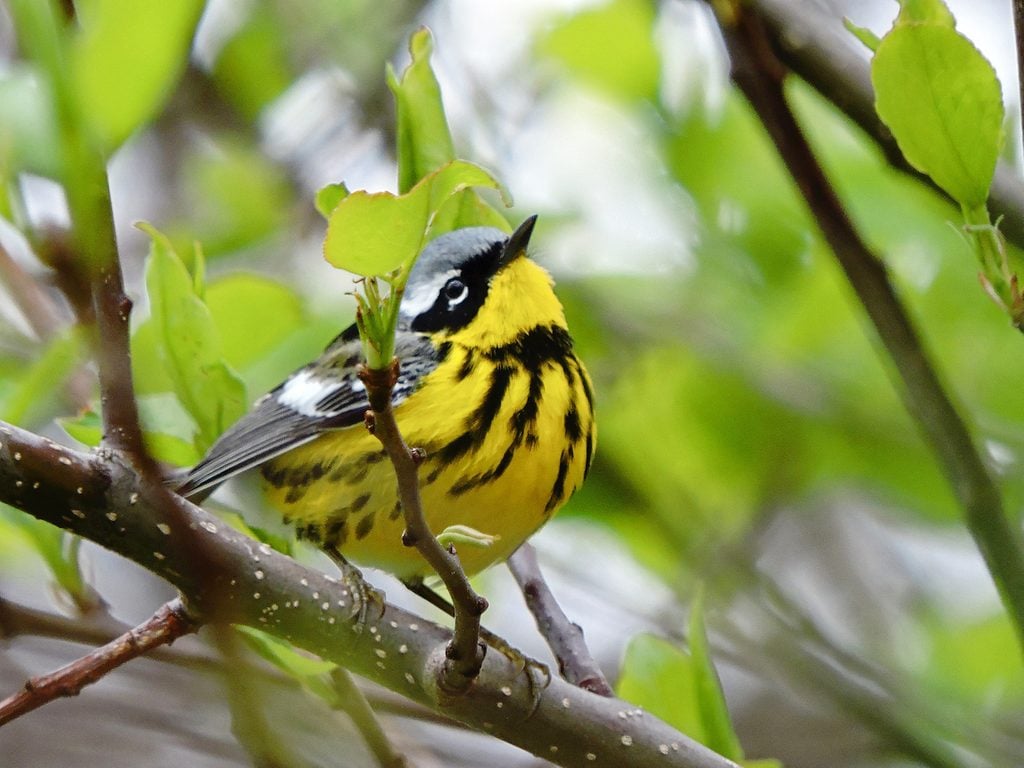
To put it simply–magnolia warblers are just plain cute.
These small, sweet borbs are worthy of adding to your life list on looks alone, though there’s a lot more to these captivating creatures. They’re elusive little ones, which means you’ll want to be strategic when attempting to spot one in the wild.
“They are a great little species, and they are certainly very enigmatic,” said Stacy Hill, an animal keeper in the Bird House at the Smithsonian’s National Zoo & Conservation Biology Institute. “They are always busy in the canopy–and they are really a special bird.”
On This Page
What Does a Magnolia Warbler Look Like?
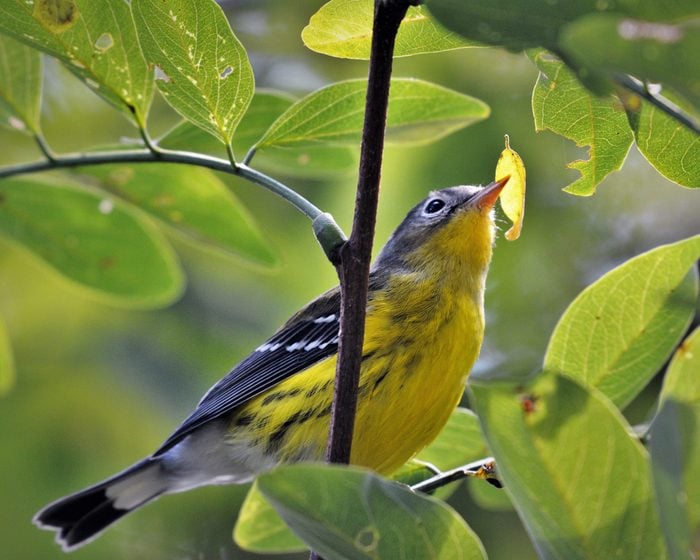
“The magnolia warbler is quite small, with a very notable small, pointy beak. Its primary colors are grey, black and yellow,” said Stacy.
When considering color alone, this small, long-tailed songbird is often confused for Kirtland’s warbler or Canada warbler. And it’s even more confusing as their ranges overlap at times.
The easiest distinguishing feature from other black-and-yellow warblers is its white accents–especially those on its wings and long tail.
“It’s very notable in flight,” said Stacy. Males have striking white accents and a black mask that streaks across its neck and chest. Some birders describe the black markings as looking like a necklace. Females are more muted–mostly grey with smaller white wingbars. Juveniles are primarily grey with black and yellow touches.
Why Is the Bird Called a Magnolia Warbler?
Ornithologist Alexander Wilson named the species in 1810 after discovering it in a magnolia tree in Mississippi, though that’s a misnomer.
“It is a great lovely name,” said Stacy, “but not indicative of what it likes to use for most of its habitat. For a common name it has stuck.”
Magnolia Warbler Habitat and Range
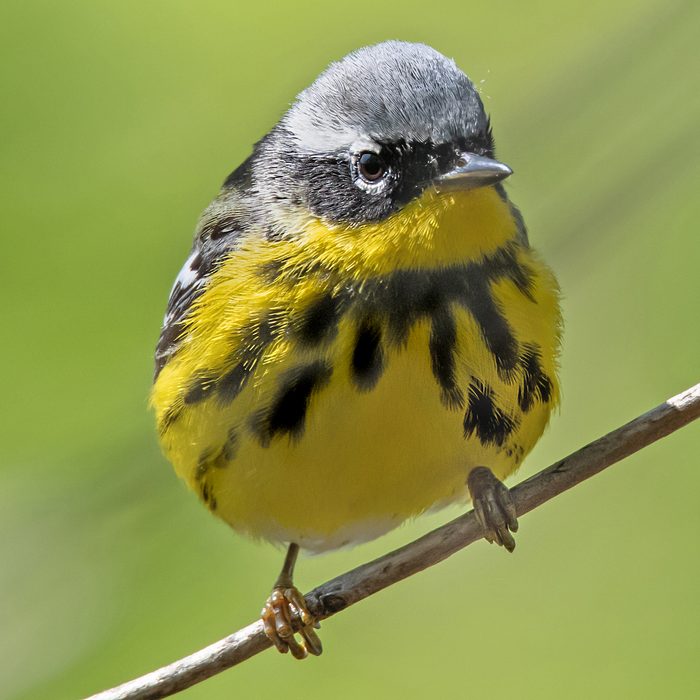
This elusive creature is here and gone quickly.
It only passes through the eastern half of the U.S. on its way from Central America and the Caribbean up to its breeding grounds in Canada–and vice versa. This means we have a narrow window for observation. It travels north between the end of March and early May. Then it returns south between September and November.
Your best chance to catch a glimpse of one is during migration.
Magnolia Warbler Nesting Habits
Those who live up north may discover a breeding pair in the Northeast or near the Great Lakes. They primarily breed in Canada’s dense coniferous, boreal forests of pine and spruce.
Male magnolia warblers arrive in breeding grounds at about the same time as their competitors, and work to establish their territories. To find a mate, he shakes his tail feathers.
“She may return that display,” said Stacy.
Once mated, the pair prepares a cup nest among dense evergreens with loosely-constructed grasses, weeds stalks and twigs lined with horsehair fungus. According to the Smithsonian, female magnolia warblers typically lay three to five eggs per clutch. The eggs are white with multicolored speckles.
Magnolia Warblers Songs and Calls
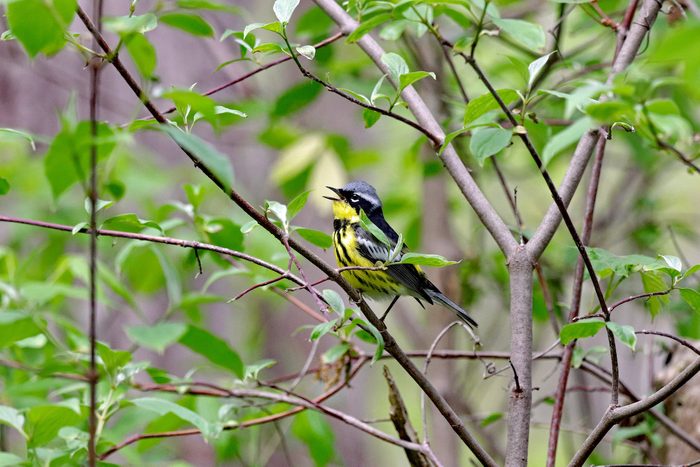
“[Females don’t] necessarily sing,” said Stacy. “There is not a lot of recorded female song in this species.”
What happens after is a mystery. We know the male approaches the female and courts her with his song and dance, though research can still be done to expand upon our knowledge of their courtship behaviors. The size of this bird makes it hard to band and track. And as its conservation status is of least concern, research dollars are limited.
We do know that males have two notable song types–one for territory defense and another communicating with a female.
Bird sounds courtesy of The Cornell Lab of Ornithology
What Do Magnolia Warblers Eat?
Your best bet to spot this songbird is by hiking through your local woods during its migration timeframe. It’s an insect-eater and rarely visits backyards. In spring and summer, they rely heavily on caterpillars and larvae.
To entice one to your backyard, you can try putting our suet or dried mealworms in your feeder. “Provide a lot of native plant species and limit your use of pesticides,” said Stacy.
Draw them in by planting native trees and shrubs to attract the insects and larvae they eat. The songbird occasionally eats fruit or nectar.
Does the Magnolia Warbler Face Any Threats?
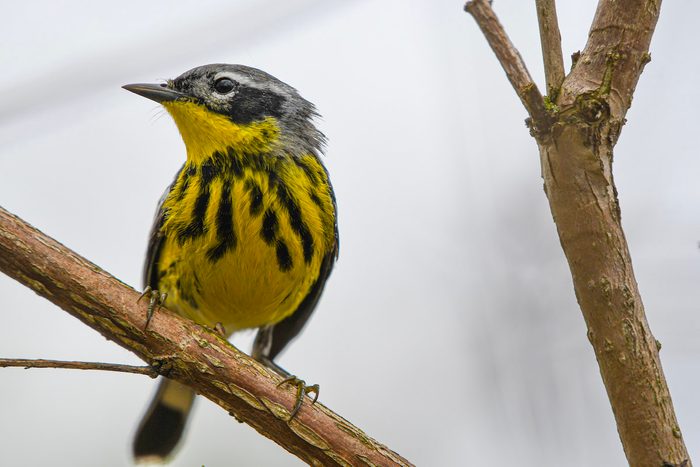
Light pollution disorients many birds, including magnolia warblers, and can cause collisions. “They use stars, the moon and sometimes the earth’s magnetic fields to travel,” said Stacy.
Organizations including the National Audubon Society tout the “Lights Out” program, encouraging people to turn off their outdoor lights at night during peak migration periods.
About the Expert
Stacy Hill is an animal keeper in the Bird House at the Smithsonian’s National Zoo & Conservation Biology Institute. The zoo cares for nearly 80 species of birds in its aviaries, including a breeding pair of magnolia warblers.
Sources
- All About Birds – magnolia warbler
- National Audubon Society – magnolia warbler
- Smithsonian National Zoo & Conservation Biology Institute
Why Trust Us?
For nearly 30 years, Birds & Blooms, a Trusted Media Brand, has been inspiring readers to have a lifelong love of birding, gardening and nature. We are the #1 bird and garden magazine in North America and a trusted online resource for over 15 million outdoor enthusiasts annually. Our library of thousands of informative articles and how-tos has been written by trusted journalists and fact-checked by bird and garden experts for accuracy. In addition to our staff of experienced gardeners and bird-watchers, we hire individuals who have years of education and hands-on experience with birding, bird feeding, gardening, butterflies, bugs and more. Learn more about Birds & Blooms, our field editor program, and our submission guidelines.
Are Cranesbill Geraniums Annuals or Perennials?
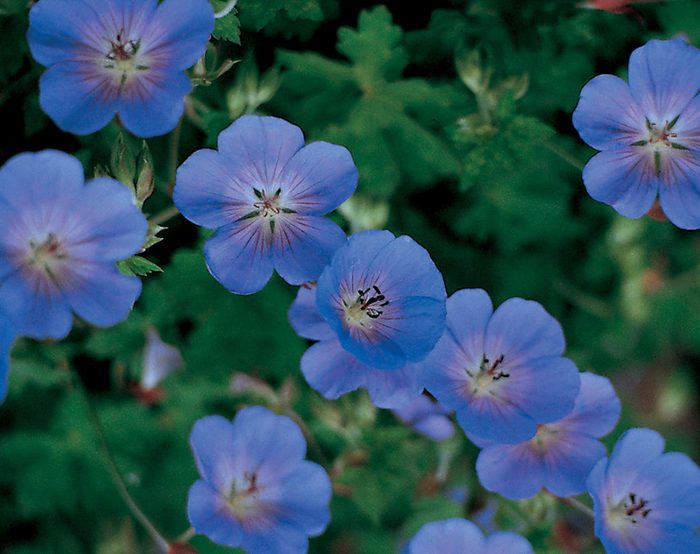
Don’t confuse the cranesbill geranium with annual Pelargonium geraniums that fill garden centers every spring. All 300 species of cranesbill geraniums are perennials, which means they’ll come back each year.
Learn more fascinating geranium plant facts.
How to Grow Cranesbill Geraniums
- Scientific name: Geranium spp.
- Common name: True geranium or cranesbill
- Hardiness zones: 4 to 10
- Light needs: Full sun to partial shade
- Soil: Well-draining
- Water needs: Drought tolerant once established
- Flower colors: White, blue, pink, purple
- Attracts: Bees and butterflies
Georgia Clay, plant selections manager for Monrovia, says, “Cranesbill is really hardy and a good choice for anyone across the United States, from coast to coast and everywhere in between.”
These plants are low-maintenance and pretty adaptable. “They do well in full sun or partial sun and tend to like to be fairly dry—just don’t let them completely dry out. For the best flowering and most vigorous growth, choose a partial shade or full sun site. If they are getting hit hard with hot sun, you will need to water more frequently,” Georgia says.
Problems with these perennials should be few. “Slugs and snails can eat spring shoots, if they are too wet you can get mildew, but they are pretty stress-free plants,” she says. Deer generally leave these plants alone.
When Do Cranesbill Geraniums Bloom?
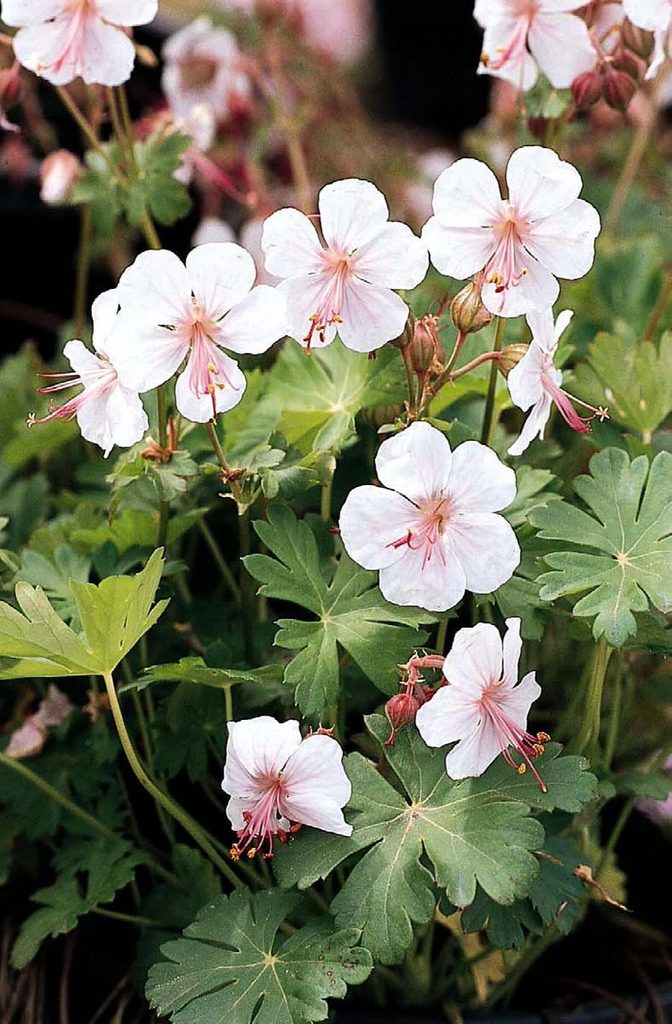
One benefit of growing cranesbill geraniums is their really long bloom cycle. Georgia has a trick to get the plants to rebloom after they start to slow down.
“I recommend shearing the plants back, and they will regrow within weeks. They will re-bloom and fill out again in the same summer,” she says.
When the plant begins to die back, cut them back in the fall after the growing season is done (between August and October). This will keep the plant dormant for the winter and help store its energy for the spring.
Does Cranesbill Spread?
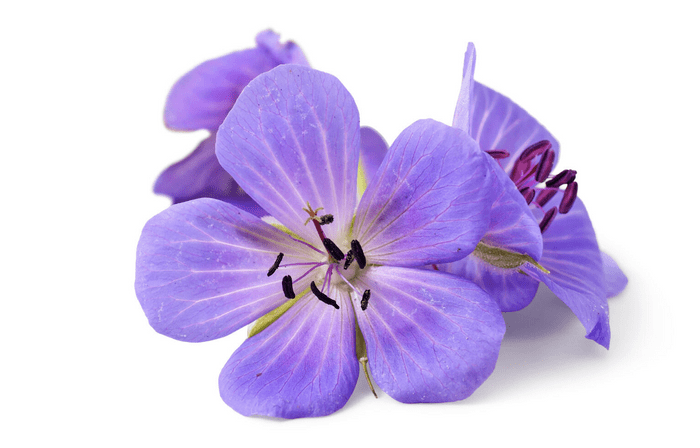
These plants can and do spread by seed, but not uncontrollably—it’s not known as a weedy plant. Some varieties like Rozanne are sterile.
Can You Grow Cranesbill in Containers?
“It would make a great container plant,” Georgia says, crediting their long bloom period, unfussy nature and great drought tolerance. Keep in mind that these plants do need to go through a dormancy period in winter; she recommends that you wrap up the pots or put them in your garage.
Cranesbill Varieties
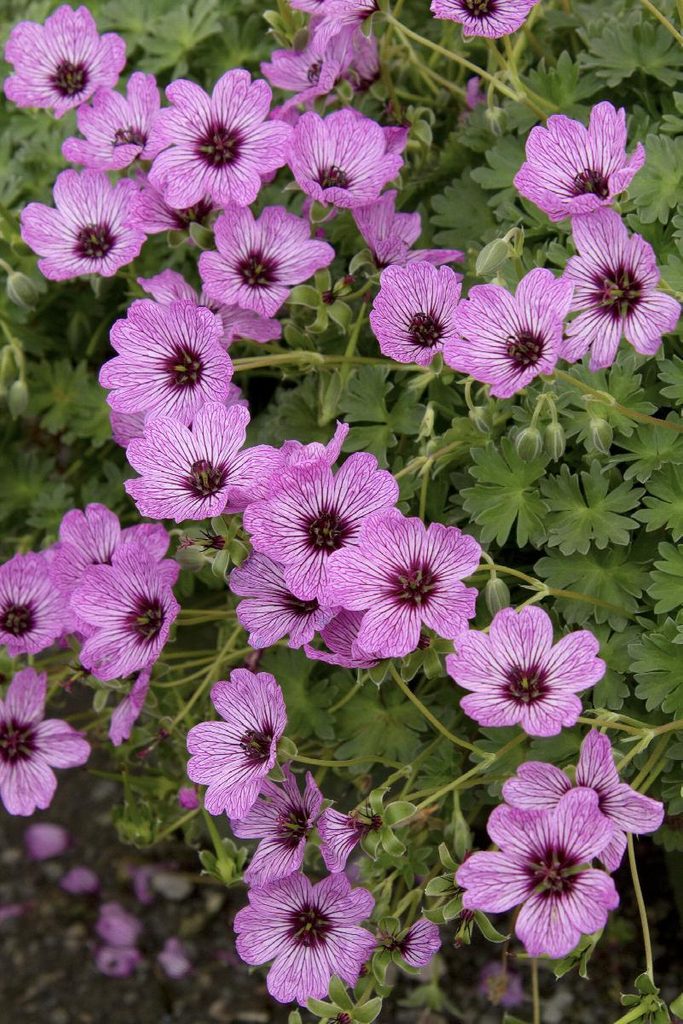
There is a big variety of hardy geraniums, so you can find a type that fits your landscape need. Ballerina grows 6 inches tall and spreads to 10 inches wide. Others like Rozanne or Biokovo are going to spread more, up to 2 to 3 feet wide.
A new variety, Storm Cloud, is more of a clumping variety, growing 1 1/2 feet tall and wide. “Storm Cloud has dark foliage that’s offset with semi-double blue flowers. Even when not blooming you get a really great show,” Georgia says.
Pink lovers should try Intense. “It’s one of my absolute favorites; it produces a ton of bright pink flowers throughout the season. The foliage goes red in the fall which is really fabulous, too,” she says.
Does Cranesbill Attract Pollinators
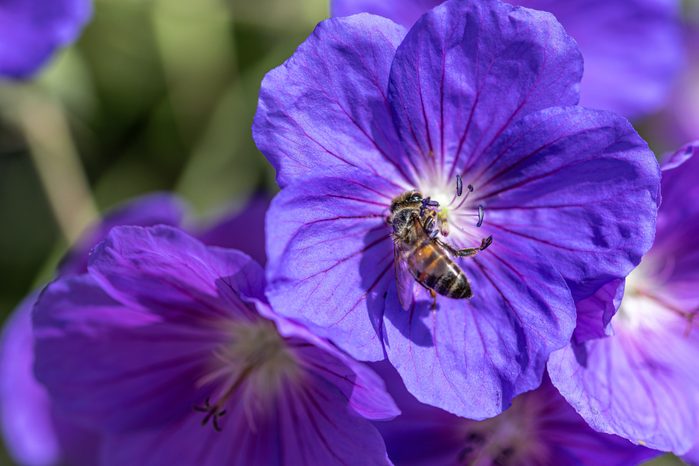
Georgia says based on the shape of flowers, she sees cranesbill attracting short-tongued insects, including native bees, such as mason bees and bumblebees, as well as butterflies.
About the Expert
Georgia Clay has worked for five years as the plant selections manager for Monrovia. She studied horticulture at Oregon State University.
Sources
Why Trust Us?
For nearly 30 years, Birds & Blooms, a Trusted Media Brand, has been inspiring readers to have a lifelong love of birding, gardening and nature. We are the #1 bird and garden magazine in North America and a trusted online resource for over 15 million outdoor enthusiasts annually. Our library of thousands of informative articles and how-tos has been written by trusted journalists and fact-checked by bird and garden experts for accuracy. In addition to our staff of experienced gardeners and bird-watchers, we hire individuals who have years of education and hands-on experience with birding, bird feeding, gardening, butterflies, bugs and more. Learn more about Birds & Blooms, our field editor program, and our submission guidelines.
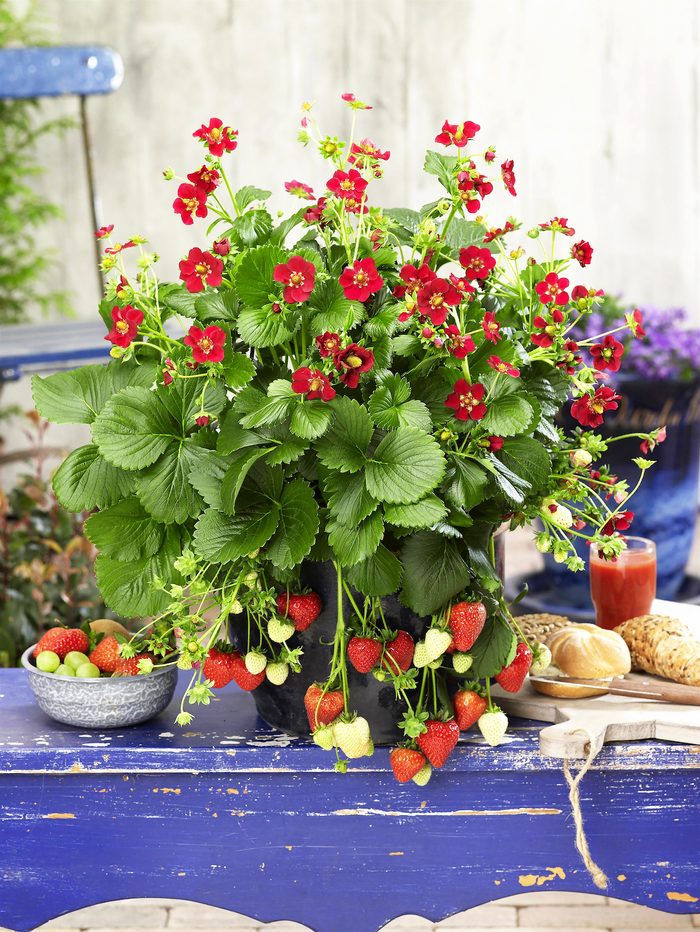
Sweet, juicy strawberries are a delightful summer treat—and are easy to grow in a home garden. These productive plants are perennial, returning year after year, and depending on the type, can provide months of mouthwatering berries. Planting a strawberry patch can save you lots of money too! Here’s how to grow strawberries in your backyard.
On This Page
June-bearing vs Everbearing Strawberries
There are three main types of strawberries: everbearing, June-bearing and day-neutral. Everbearing strawberry plants fruit in early summer and again in autumn. June-bearing plants produce a heavy crop of large, juicy berries from late spring through early summer. Day-neutral strawberries produce a modest but continual harvest from the late spring through early autumn.
To encourage vigorous plants, pinch all flowers that develop on June-bearing plants that first year. With ever-bearing and day-neutral varieties, pinch flowers until late June and then let subsequent blooms develop into berries.
Enjoy more fresh fruit by growing blueberries in your garden.
When to Plant Strawberries
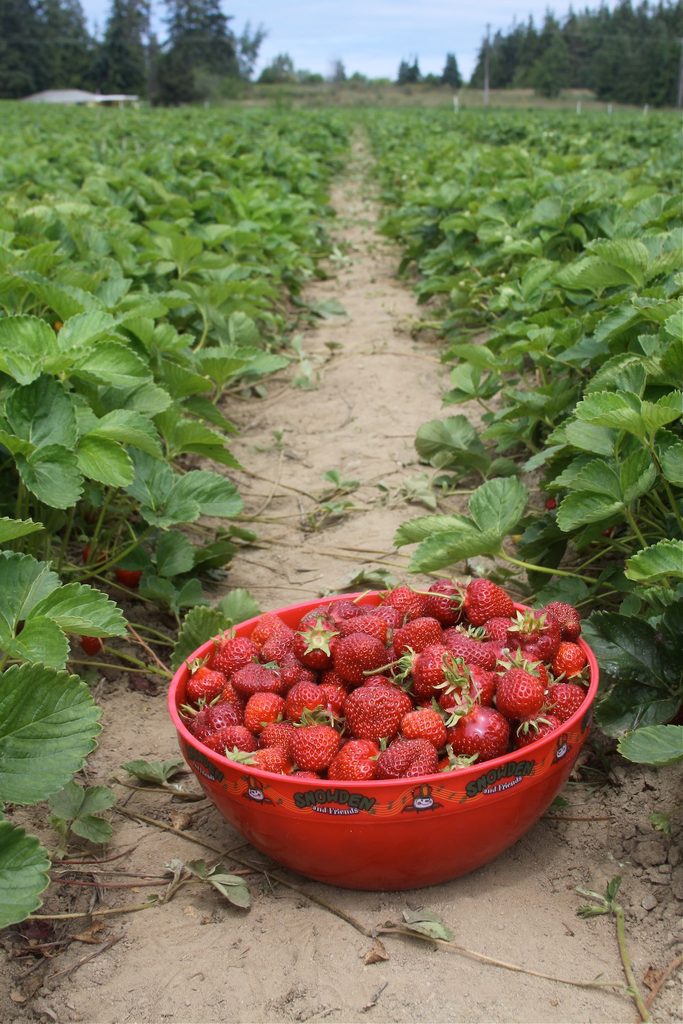
Strawberries are best planted in the spring or autumn and are available as bareroot or potted plants. Bareroot strawberries are sold without soil and can be purchased in bundles, usually of 10 to 25 plants. Choosing barerooted plants is a cost-effective way to plant a lot of strawberries at once.
Check out the top trees and shrubs with berries for birds.
Where and How to Plant Strawberries

Space strawberry plants 1 foot apart, staggering the rows to maximize the growing area.
Strawberry plants need lots of light for vigorous growth and plenty of delicious berries. Find a site that offers at least eight hours of direct sun and that has fertile, well-draining soil.
Raised beds, which provide good drainage and allow you to control the soil mix, are ideal for strawberries. If making a new raised bed for strawberries, fill it with a blend of garden soil and compost at a ratio of 3 parts soil to 1 part compost. To amend an existing garden bed for strawberries, dig in 2 to 3 inches of compost or aged manure.
You need to know these fascinating facts about berries.
Watering Tips for Strawberries
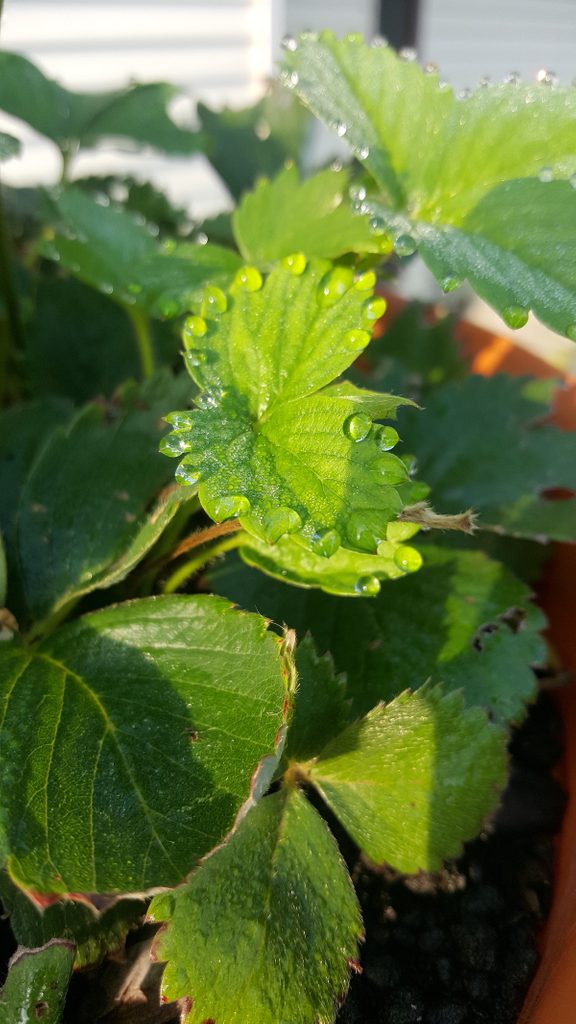
How often you water strawberry plants depends on the weather and soil type. The goal is to maintain a lightly moist soil, with strawberries planted in average garden soil needing around an inch of water each week.
Water in the morning so any moisture that splashes on the leaves has time to evaporate before nightfall. This helps reduce the occurrence of plant diseases. Hand-water with a watering can or long-handled watering wand, or make irrigation a snap by running a soaker hose between the strawberry plants.
Learn how to grow a black chokeberry shrub in your yard.
Strawberry Plant Pruning and Mulching Tips
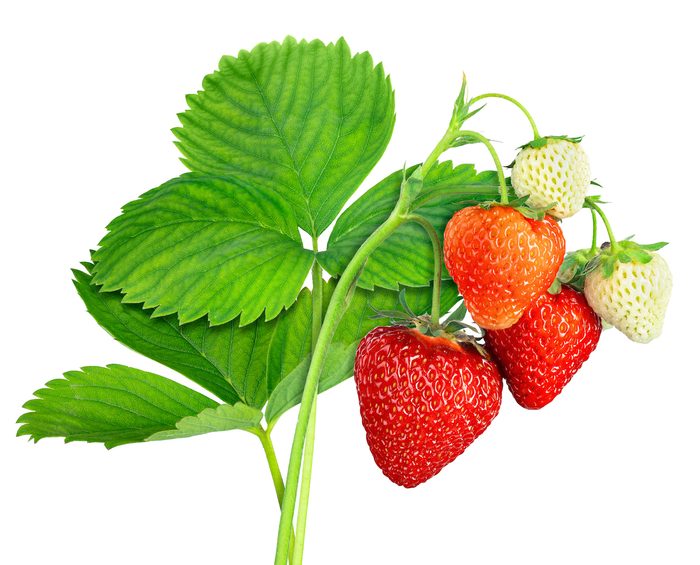
To encourage vigorous plants, pinch all flowers that develop on June-bearing plants that first year. With ever-bearing and day-neutral varieties, pinch flowers until late June and then let subsequent blooms develop into berries.
In regions where the temperature dips below 15 degrees in winter, mulch the plants to prevent damage. After the first few autumn frosts, spread a 3-to-4-inch-deep layer of straw or shredded leaves on top of the plants. Come spring, rake away most of the mulch, leaving a thin layer to deter weeds, hold soil moisture and keep the berries clean.
Are American pokeweed berries poisonous?
How to Grow Strawberries in Pots
The best strawberries for pots, planters and window boxes are day-neutral, which produce over a long season.
Pick a container at least 12 inches in diameter with drainage holes, and fill it with a 50-50 blend of potting mix and compost. Set the plants 8 to 10 inches apart, or plant three strawberry plants in a 12-inch-diameter container.
Keep the growing mix lightly moist throughout the season and use a liquid organic fertilizer once a month.
To provide potted plants’ roots with added insulation from the cold, store them in an unheated garage for winter, move them into the garden in fall or grow strawberries as annuals.
Next, learn how to grow an indoor lemon tree.
Sources
- University of Minnesota Extension, “Growing strawberries in the home garden“
- Cornell Cooperative Extension of Chemung County, “Growing Strawberries in the Home Garden“
Why Trust Us
For nearly 30 years, Birds & Blooms, a Trusted Media Brand, has been inspiring readers to have a lifelong love of birding, gardening and nature. We are the #1 bird and garden magazine in North America and a trusted online resource for over 15 million outdoor enthusiasts annually. Our library of thousands of informative articles and how-tos has been written by trusted journalists and fact-checked by bird and garden experts for accuracy. In addition to our staff of experienced gardeners and bird-watchers, we hire individuals who have years of education and hands-on experience with birding, bird feeding, gardening, butterflies, bugs and more. Learn more about Birds & Blooms, our field editor program, and our submission guidelines.
On This Page
What Does an Albino Crow Look Like?
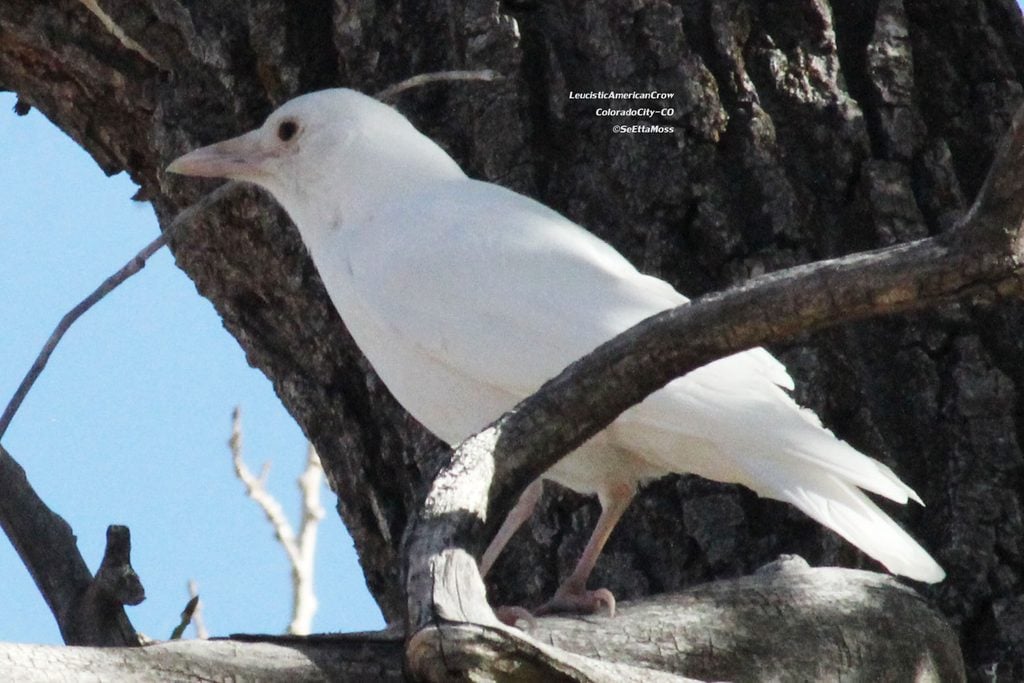
This American crow (above), photographed by Birds & Blooms contributor SeEtta Moss, has white feathers and pink feet, legs, and a pink bill…but that doesn’t necessarily make it an albino crow.
According to Kevin McGowan, senior course developer with the Cornell Lab of Ornithology, color variations in crows can occur for a variety of reasons. “Having a normal-plumaged bird is a complicated system,” he says, likening the factors that influence a bird’s coloring to starting a car. “If you turn your key and the car won’t start, there are a thousand things it could be.”
Certainly, one possibility is albinism, which occurs when the bird’s genetics result in cells that improperly produce melanin. This could turn the bird’s feathers white, and its skin pink. In such a case, the bird’s eyes would be also be red.
Are albino or leucistic robins rare?
Are Albino Crows Healthy?
Because plumage and feathers play key roles in a bird’s daily life and survival, albinism can be a detriment. It can affect the bird’s ability to find a mate, and even hurt the bird’s eyesight.
“True albinos don’t have any pigment in their eyes, so they’re very light-sensitive and probably can’t see as well as normal birds,” Kevin explains. He also highlights that melanin provides strength for feathers, which means the feathers of albino birds tend to be weaker than those of their normally colored counterparts. “There’s a reason albinism is rare,” he says. “It’s a bad condition to have.”
Is this white mourning dove albino?
Leucistic Crows
Aside from albinism, several other conditions or factors could cause a crow to lack coloring in its feathers or elsewhere on its body. One of the more common is leucism, also referred to as partial albinism.
“When a bird is developing as an embryo, we know there are mutations that can occur that mess with the distribution of melanocytes,” Kevin says, referencing cells that create melanin and deposit it throughout the bird’s feathers and skin. “Those birds have pure white patches scattered across the body, often symmetrically on each side. That’s because of bad distribution of the cells when the thing was developing. That’s called leucism.”
The white crow in the image above, then, appears to be leucistic.
See photos of rare white hummingbirds.
Other Causes of White Feathers
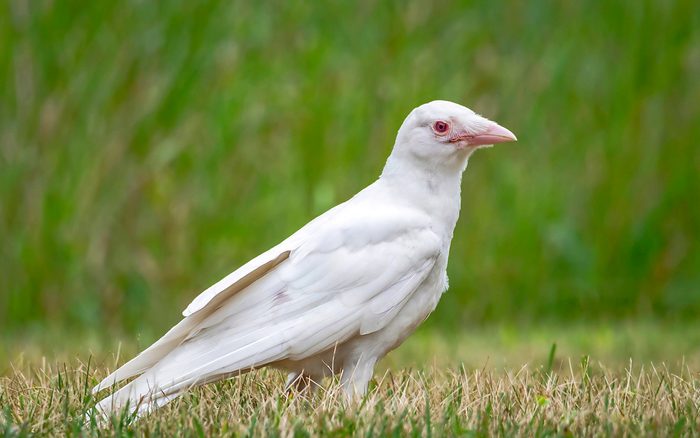
Albinism and leucism aren’t the only reasons a crow would develop unusually colored feathers. Sometimes, Kevin explains, external factors or age can play a role.
“There are things that can happen in the development of the feathers themselves, such that there’s something wrong with [the bird’s] nutrition, or they experience a deprivation in food, or there’s an illness or something that can interfere with the development of the melanin one time,” he says, explaining that it occurs frequently with juvenile crows. “That seems to be a developmental thing, a one-time accident sort of deal. The next year, they don’t have white in their feathers anymore.”
Meet the fish crow: the American crow’s coastal cousin.
Do Crows Turn Gray as They Age?
In addition, similarly to humans, older crows sometimes start to “go gray.” Rather than developing gray hairs like humans do, age affects the color of their feathers. “There’s progressive graying, which is that the cells that produce pigment die, and it’s like turning gray,” Kevin explains. “Certain cells can’t produce pigment anymore, and you end up with a bird that gets whiter and whiter.”
Another complicating factor: birds produce two kinds of melanin, and sometimes issues only occur with one. This can result in a bird that is grayer, or redder, than the others. “Sometimes we get gray crows that aren’t making the rusty brown melanin, and sometimes we get brownish crows that are not making the gray melanin,” Kevin says. “There can be gradations of that, and you can get some birds that are very pale. That’s called dilute plumage.”
Kevin has never personally seen an albino crow, although he has seen crows with variations in coloring. “It’s an interesting complex of things,” he says. “I’ve seen some very unique birds through the years. Not very often, but often enough to keep things interesting.”
Next, find out if crow sightings have meaning?
About the Expert
Lifelong birder and ornithologist Dr. Kevin McGowan is a senior course developer for the Cornell Lab of Ornithology’s Bird Academy. He earned a Ph.D in biology at the University of South Florida.
Sources
- Cornell Lab of Ornithology’s All About Birds, “What can cause birds to show weird color variations?“
- Project FeederWatch, “Albinism and Leucism“
Why Trust Us
For nearly 30 years, Birds & Blooms, a Trusted Media Brand, has been inspiring readers to have a lifelong love of birding, gardening and nature. We are the #1 bird and garden magazine in North America and a trusted online resource for over 15 million outdoor enthusiasts annually. Our library of thousands of informative articles and how-tos has been written by trusted journalists and fact-checked by bird and garden experts for accuracy. In addition to our staff of experienced gardeners and bird-watchers, we hire individuals who have years of education and hands-on experience with birding, bird feeding, gardening, butterflies, bugs and more. Learn more about Birds & Blooms, our field editor program, and our submission guidelines.
On This Page
Birding Challenge: Rufous vs Allen’s Hummingbird
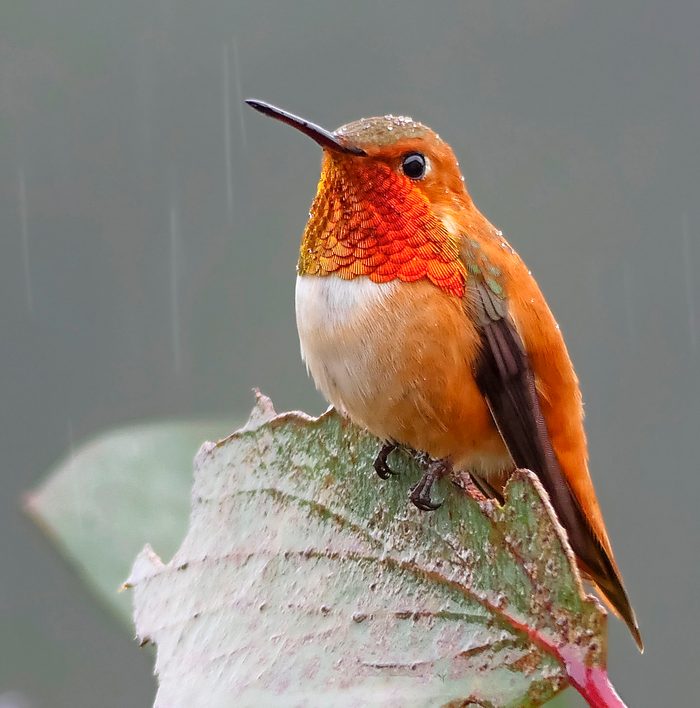
You might call these hummingbird lookalikes a real humdinger. It’s tricky to tell rufous vs Allen’s hummingbirds apart, largely because of their orange plumage and overlapping ranges. Thankfully, there are a few tricks you can use to determine whether you’re looking at an rufous or Allen’s hummingbird. Here’s how.
Learn to identify 15 types of hummingbirds found in the United States.
Rufous Hummingbird Identification
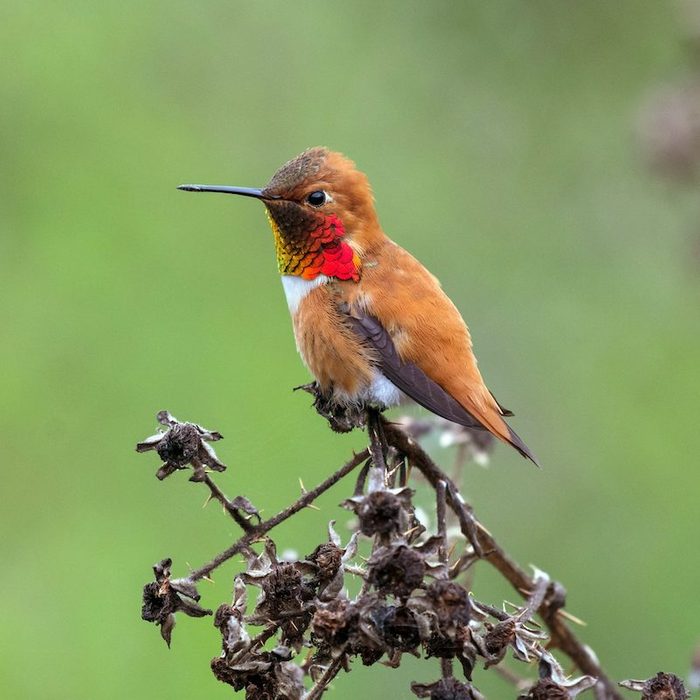
Adult male rufous hummingbirds have a uniformly orange back and tail, though some have glimmers of green. The second feather from the middle of their tail has a notched tip that’s visible when the tail is fanned out.
As far as observable behaviors, males dive in oval shape around perched females. That said, they can show variation when practicing or defending their territory. Their range covers a wide swath of western states, including Alaska and the Rockies.
See the brilliant spectrum of hummingbird colors.
Allen’s Hummingbird Identification
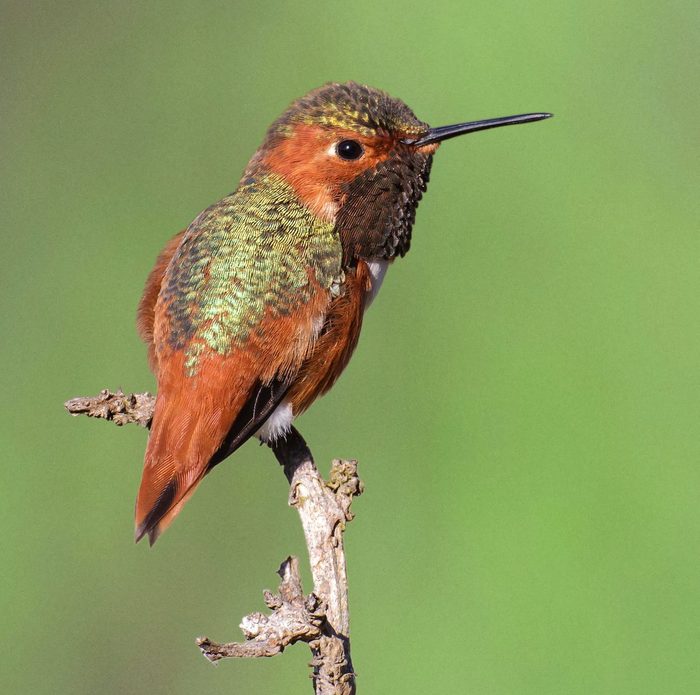
To identify a male Allen’s hummingbird, look for an overall a mix of orange and green on adult males; females and juvenile males are nearly identical in hue to rufous. An Allen’s outermost feathers are slimmer and pointier than the rest.
When flying around perched females, males do so in a “J” shape. Their range is restricted to West Coast in breeding season, and Southern California and Arizona during migration.
Meet the Costa’s hummingbird: jewel of the desert.
Key Differences: Range and Field Marks
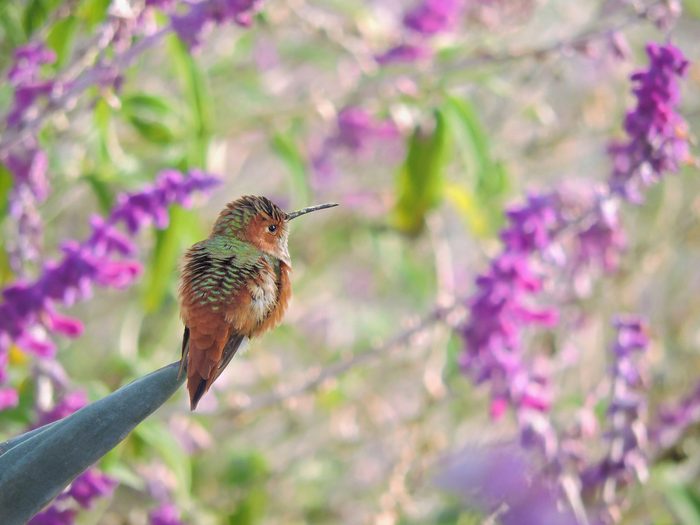
Perhaps the clearest and most easily spotted difference between rufous vs Allen’s hummingbirds is the clear presence of green feathers on the back of an adult male Allen’s hummingbird. On rufous hummingbirds, that green coloration is less prominent.
Also worth noting is the differences in ranges between these birds. In the United States, birders can find Allen’s hummingbirds in the lower halves of Arizona and California during migration, and along the California and Oregon coasts during breeding season. This isn’t the case for the rufous, which has a more extensive range covering a large portion of the western United States.
Complicating it all further, ornithologists have pinpointed a 200-mile zone in Oregon and California where rufous and Allen’s hummingbirds interbreed. Hybrid individuals display tiny differences in their tail shapes and courtship behaviors. Talk about a tricky bird to identify!
Next, learn how to identify an Anna’s hummingbird.
Sources
- Cornell Lab of Ornithology, rufous hummingbird
- Cornell Lab of Ornithology, Allen’s hummingbird
- Oxford University Press
Why Trust Us
For nearly 30 years, Birds & Blooms, a Trusted Media Brand, has been inspiring readers to have a lifelong love of birding, gardening and nature. We are the #1 bird and garden magazine in North America and a trusted online resource for over 15 million outdoor enthusiasts annually. Our library of thousands of informative articles and how-tos has been written by trusted journalists and fact-checked by bird and garden experts for accuracy. In addition to our staff of experienced gardeners and bird-watchers, we hire individuals who have years of education and hands-on experience with birding, bird feeding, gardening, butterflies, bugs and more. Learn more about Birds & Blooms, our field editor program, and our submission guidelines.
On This Page
What Makes a Plant Invasive?
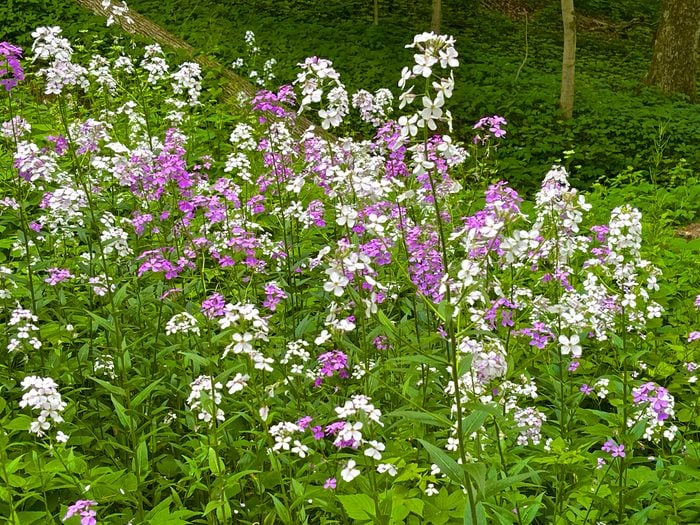
Invasive plants have two characteristics. First, these plants are nonnative to the ecosystem, and second, they cause or are likely to cause harm to humans, the environment or the economy.
Check your garden—you might have one of these surprising invasive flowers.
Invasive Plant Damage Is Costly
The invasive aquatic plant Elodea is the first freshwater invasive plant known to have appeared in Alaska. It chokes out native vegetation and spreads easily and rapidly, needing only a 2-inch clipping of its stem to take root in a new location. Because it disrupts native vegetation and damages the quality of aquatic environments, experts say it could cost the Alaskan sockeye salmon industry as much as $159 million a year.
Psst—never plant these invasive shrubs (and what to grow instead!)
Don’t Leave Purple Loosestrife!
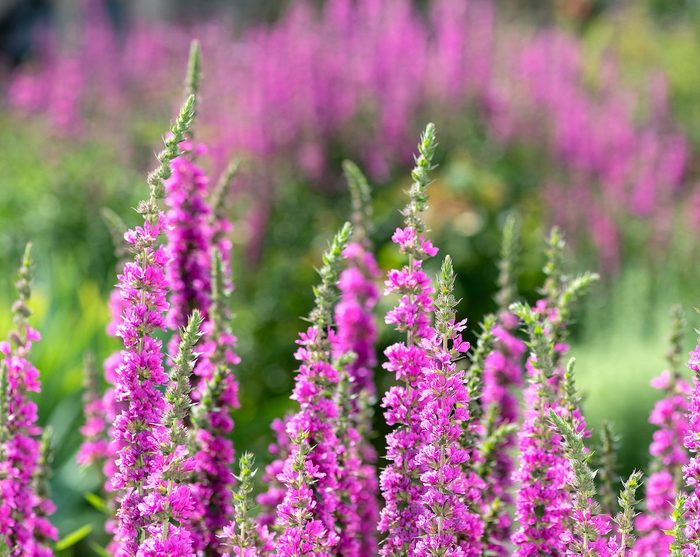
Many invasive plants are known for spreading quickly. The deceptively pretty invasive purple loosestrife can produce more than 2.7 million seeds annually. Native to Europe and Asia, purple loosestrife looks like a lovely flower—but it’s a headache for many gardeners in the United States and Canada. It grows in wetland environments and crowds out native species. Roots can send out 30 to 50 shoots, which creates an interconnected web of plants.
In addition to purple loosestrife, keep an eye out for the worst invasive plants.
Invasive Plants Are Difficult to Remove
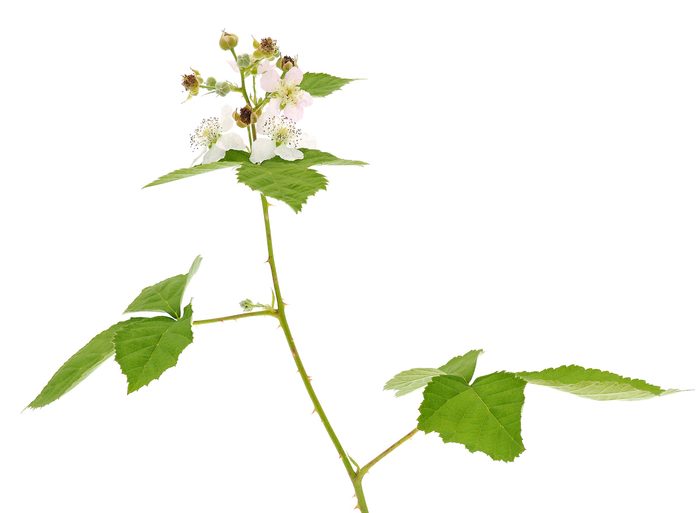
Himalayan blackberry is invasive in the Pacific Northwest, forming impenetrable thickets of up to 500 canes per square yard. As with many native plants, it is incredibly difficult to control and eradicate, especially when attempting to pull it out by the roots.
Here’s how to remove invasive plants from your garden for good.
Russian Thistle Spread Across the Southwest
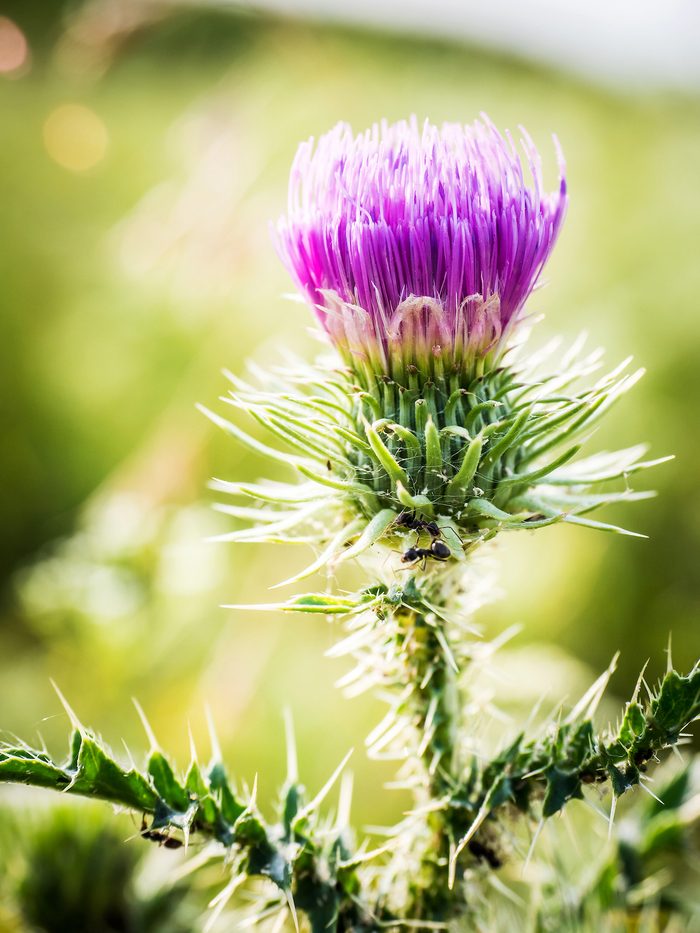
Better known as tumbleweed, Russian thistle arrived in the U.S. in 1873. Its rapid spread was accidental. Today, it infests approximately 100 million acres, especially in the American Southwest.
Should you get rid of Canada thistle? Find out what the experts say.
Some Invasive Plants Are Harmful to Humans
Lots of invasive plants hurt the environment, but giant hogweed hurts people, too. Its leaves grow up to 5 feet across, and its toxic sap causes severe skin blisters when exposed to sunlight. If you have the misfortune of coming into direct contact with giant hogweed, wash the affected skin with soap and water as soon as possible. Next, make sure to keep the affected area out of direct sunlight for at least 48 hours.
Is a black locust tree invasive?
Kudzu Vine Grows Extremely Fast

In summer, kudzu vine can grow up to 1 foot every day, reaching lengths of over 100 feet. Some refer to it as “the vine that ate the South” because of its prevalence in the southern United States. Unfortunately, it was once intentionally planted there as a means of controlling erosion.
Next, find out if trumpet vine is an invasive plant.
Sources
- New York State Department of Environmental Conservation, “Giant Hogweed“
- Minnesota Department of Natural Resources, “Purple loosestrife“
- King County, Washington, “Himalayan blackberry identification and control“
- The Nature Conservancy, “Kudzu: The Native Vine That Ate the South“
- National Park Service, “Elodea: Alaska’s First Invasive Aquatic Plant Continues to March Across the State“
- National Oceanic and Atmospheric Administration, “What is an invasive species?“
- UC Riverside Center for Invasive Species Research, “Russian Thistle“
- United States Department of the Interior, “Invasive Species Strategic Plan 2021-2025“
- Clackamas Soil and Water Conservation District, “October Invasive Weed of the Month: Himalayan Blackberry“
Why Trust Us
For nearly 30 years, Birds & Blooms, a Trusted Media Brand, has been inspiring readers to have a lifelong love of birding, gardening and nature. We are the #1 bird and garden magazine in North America and a trusted online resource for over 15 million outdoor enthusiasts annually. Our library of thousands of informative articles and how-tos has been written by trusted journalists and fact-checked by bird and garden experts for accuracy. In addition to our staff of experienced gardeners and bird-watchers, we hire individuals who have years of education and hands-on experience with birding, bird feeding, gardening, butterflies, bugs and more. Learn more about Birds & Blooms, our field editor program, and our submission guidelines.
Not only are fast growing vines and climbing flowers great to look at, they serve a definite purpose in backyards. Vining plants can add height and fullness to any flower garden with their sky-high antics. Take a look at these plant picks for ideas, then start adding flowering vines to your backyard.
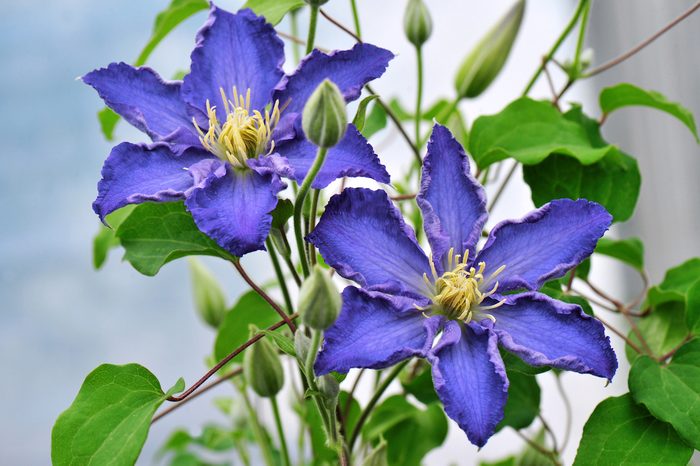
On This Page
Clematis
Clematis spp., Zones 3 to 9
This cold-hardy vine is available in a wide range of colors. Different clematises bloom anytime from spring to frost, attracting butterflies and hummingbirds. These vines need “warm heads and cool feet” in the form of full sun in moist, well-draining soil that has been mulched or underplanted with other perennials.
Why we love it: Equally attractive are the large, fluffy seed heads, which develop on some vines in fall and remain well into winter.
After you finish reading our list of fast growing vines and climbing flowers, discover the best vines to grow for hummingbirds.
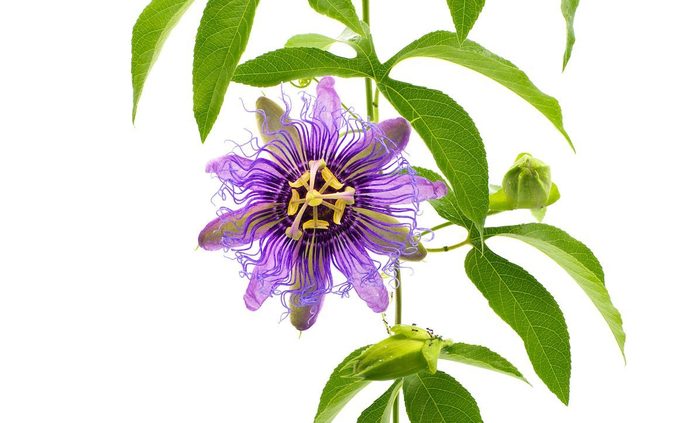
Purple Passionflower
Passiflora incarnata, Zones 5 to 9
Hummingbirds love the passionflower’s intricate blooms, while butterflies flock to the vine as it is a larval host plant. Gardeners in the northern portion of its hardiness zones may not see fully formed fruit on this plant. It’s a native perennial that’s drought tolerant and grows in full sun or part shade.
Why we love it: The intricate blossoms can be cut and placed in small vases.
For another drought-tolerant option, try heat-loving butterfly vine.
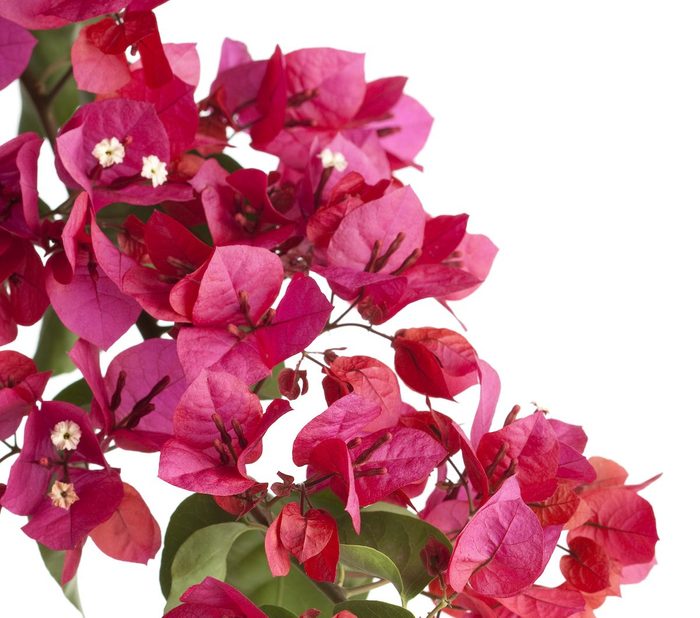
Bougainvillea
Bougainvillea spp., Zones 9 to 11, annual elsewhere
This flowering vine produces masses of neon-bright, papery thin “flowers,” which are actually colorful bracts. The true flowers are small and white, and are nestled within. This sun-loving, drought-tolerant plant needs acidic soil. In the South, bougainvillea can get quite large when trained up the side of a house.
Why we love it: Though popular as a vine, it also functions as a shrub or a container plant.
Add lilac vine to backyard flower gardens.
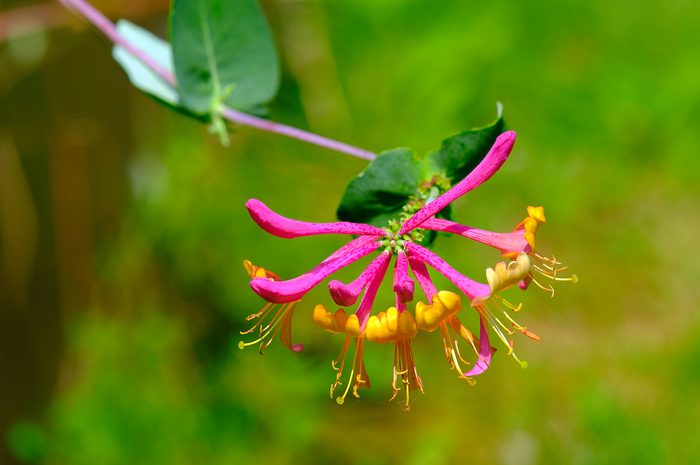
Coral Honeysuckle
Lonicera sempervirens, Zones 4 to 9
The native coral honeysuckle (not the invasive L. japonica) has long, tubular flowers that bloom in bunches, creating a fan effect. A favorite among hummingbirds, this vine is also a larval host plant for butterflies and moths.
Why we love it: The blooms last from spring into summer, then small, bird-friendly berries appear.
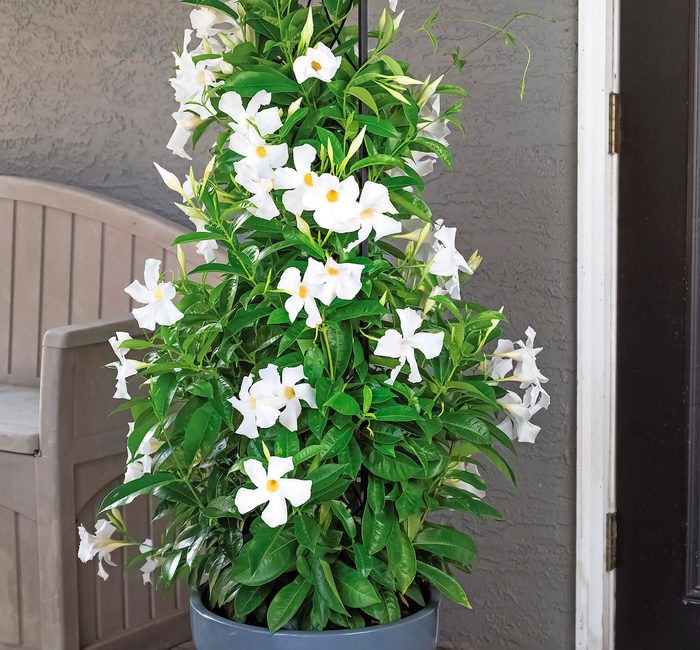
Mandevilla
Mandevilla spp., Zones 10 to 11, annual elsewhere
Nothing says tropical like mandevilla, which thrives in heat and humidity. Large trumpet-shaped flowers in pink, red, yellow, white, apricot, peach and lavender bloom all summer long. These woody vines are often sold as annuals but can overwinter inside.
Why we love it: Perfect for the poolside, container-friendly mandevilla can provide bold color anywhere.
Learn how to grow a climbing hydrangea vine.
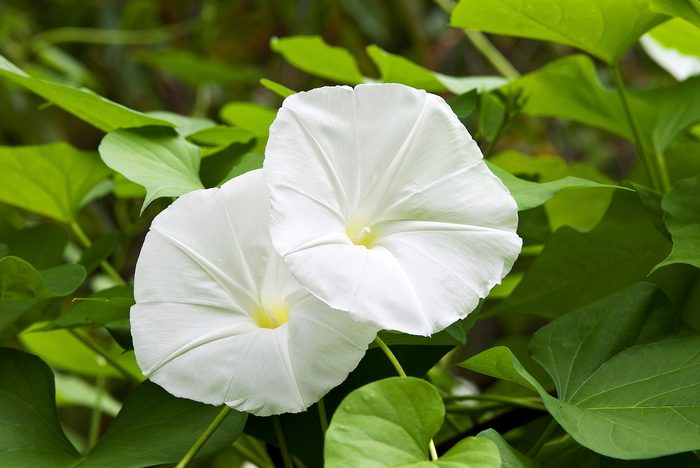
Moonflower
Ipomoea alba, Zones 10 to 12, annual elsewhere
Moonflower vines bloom fragrant white flowers at dusk for night-flying moths to pollinate. Each 5-inch-wide, flat flower is marked with a narrow five-pointed star. Preferring moist, well-draining soil and full sun, moonflowers bloom from summer to fall.
Why we love it: Kids and adults alike will love watching moonflowers open up later in the day.
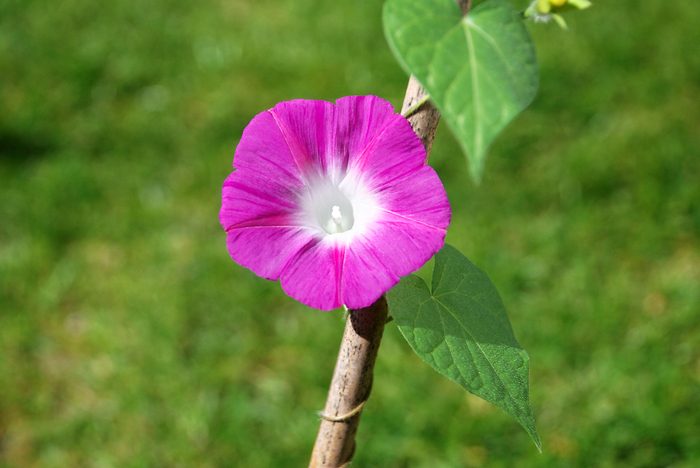
Morning Glory
Ipomoea spp., annual
Morning glory vines are available in floral colors of pink, white, blue or purple. Easy to grow from seed, the trumpet-shaped flowers open in the morning and close later in the day. Morning glories do reseed readily, so plant them with awareness of their spreading abilities.
Why we love it: Drape the lightweight vines over deck banisters, or train them up vertical structures such as obelisks.
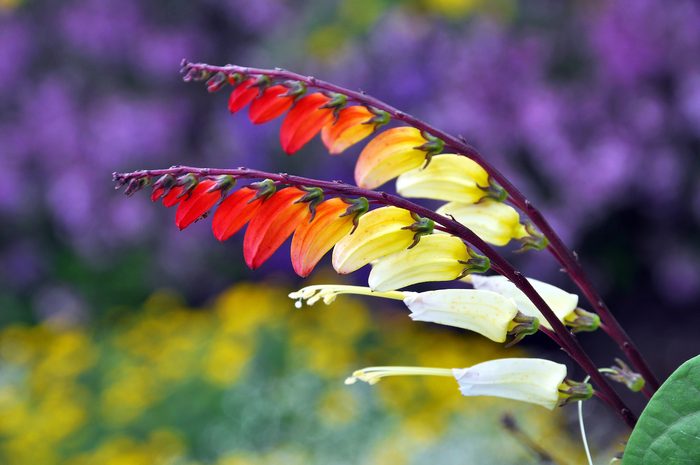
Firecracker Vine
Ipomoea lobata, Zones 9 to 11, annual elsewhere
Firecracker vine produces upright flower heads, attracting pollinators. Also commonly called Spanish flag, each branch consists of at least a dozen blossoms in a descending cascade of colors.
Why we love it: These fast growing vines grow prolifically in early summer, and the flowers bloom in late summer.
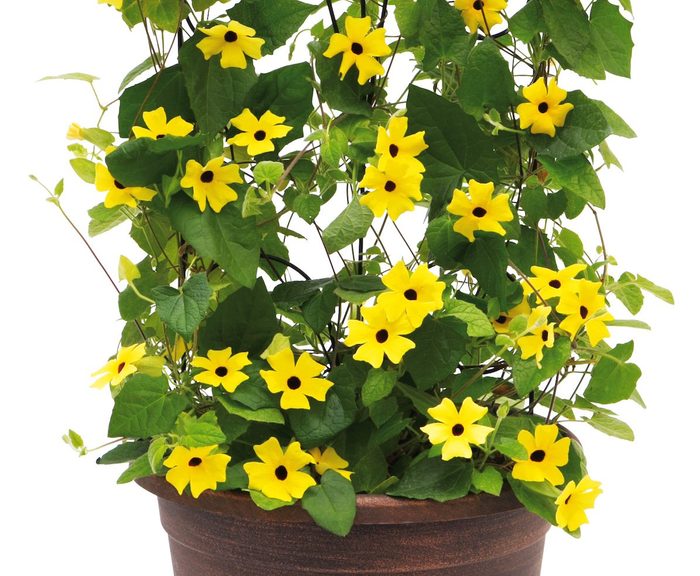
Black-Eyed Susan Vine
Thunbergia alata, Zones 10 to 11, annual elsewhere
Watch for hummingbirds, bees and butterflies to visit the 2-inch-wide blooms on a black-eyed Susan vine. Simple but dramatic, this vine also pops in hanging baskets.
Why we love it: Recent breeding has produced captivating colors including red, orange-red and all white.
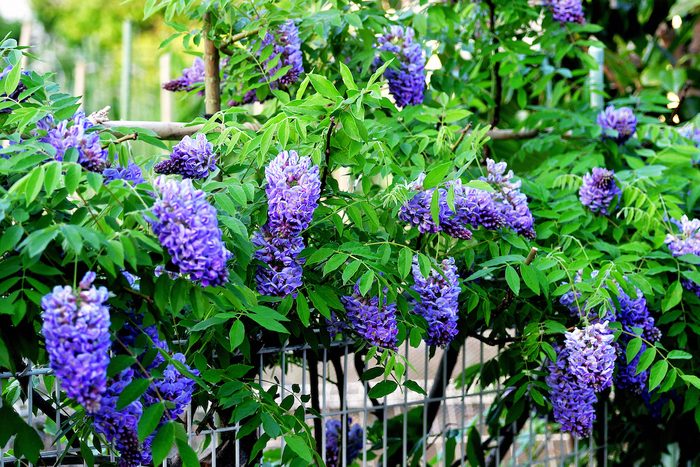
American Wisteria
Wisteria frutescens, Zones 5 to 9
This native blooms in late spring—the sweetly scented lavender blossoms attract butterflies, while the vine serves as a larval host plant for several skipper butterflies. Be sure to give this woody vine strong support and full sun.
Why we love it: For the best effect, grow this classic in an open structure, allowing the blooms to hang freely.
Invasive Vines You Should Never Grow
Not all fast growing vines are good for your garden. Avoid these plants known to cause issues:
- Chinese wisteria (Wisteria sinensis)
- English ivy (Hedera helix)
- Japanese honeysuckle (Lonicera japonica)
- Japanese wisteria (Wisteria floribunda)
- Kudzu (Pueraria montana)
- Old man’s beard (Clematis vitalba)
Next, find out if trumpet vine is invasive.
Sources
- Missouri Botanical Garden – purple passionflower
- University of Florida Extension – passionflower
- Loudoun Wildlife Conservancy – native vines for wildlife
- North Carolina Wildlife Federation – native pollinator vines
- North Carolina Cooperative Extension – coral honeysuckle
- National Audubon Society – 10 plants for a bird-friendly yard
- Virginia Native Plant Society – coral honeysuckle
- North Carolina State Cooperative Extension – American wisteria
- Virginia Native Plant Society – American wisteria
- Oregon State University Extension Service – morning glory
- Iowa State University Extension and Outreach – annual flowering vines
- University of Arkansas Division of Agriculture Research & Extension – moonflower
- Missouri Botanical Garden – moonflower
- University of Wisconsin-Madison Division of Extension – black-eyed Susan vine
- University of Arkansas Division of Agriculture Research & Extension – black-eyed Susan vine
- Clemson Cooperative Extension – clematis
- University of Nebraska-Lincoln Extension – clematis
- Michigan State University – an introduction to clematis
- Clemson Cooperative Extension – mandevilla
- University of Florida Extension – mandevilla
- North Carolina State Cooperative Extension – bouganvillea
- UC Master Gardeners of Napa County – bouganvillea
- North Carolina State Cooperative Extension – firecracker vine
- Missouri Botanical Garden – firecracker vine
- University of Arkansas Division of Agriculture Research & Extension – Spanish flag
Why Trust Us?
For nearly 30 years, Birds & Blooms, a Trusted Media Brand, has been inspiring readers to have a lifelong love of birding, gardening and nature. We are the #1 bird and garden magazine in North America and a trusted online resource for over 15 million outdoor enthusiasts annually. Our library of thousands of informative articles and how-tos has been written by trusted journalists and fact-checked by bird and garden experts for accuracy. In addition to our staff of experienced gardeners and bird-watchers, we hire individuals who have years of education and hands-on experience with birding, bird feeding, gardening, butterflies, bugs and more. Learn more about Birds & Blooms, our field editor program, and our submission guidelines.